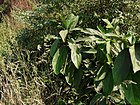Note: This is a project under development. The articles on this wiki are just being initiated and broadly incomplete. You can Help creating new pages.
Ficus hispida - Hairy Fig
Ficus hispida is a shrub or small tree. It can grow up to 17 metres tall with a bole up to 25cm in diameter. The tree is sometimes harvested from the wild for use as a food and medicine.
Contents
[hide]- 1 Uses
- 2 Parts Used
- 3 Chemical Composition
- 4 Common names
- 5 Properties
- 6 Habit
- 7 Identification
- 8 List of Ayurvedic medicine in which the herb is used
- 9 Where to get the saplings
- 10 Mode of Propagation
- 11 Cultivation Details
- 12 Commonly seen growing in areas
- 13 Photo Gallery
- 14 References
- 15 External Links
Uses
Fevers, Liver problems, Constipation, Wounds, Bubo, Vitiligo, Leucodermia.[1]
Food
Ficus hispida can be used in Food. Tender leaves and young unripe fruits are cooked as vegetable. Ripe fruits are eaten raw[2].
Parts Used
Chemical Composition
Preliminary phytochemical investigations of FH have shown the presence of Alkaloids, Carbohydrates, Proteins and Amino acids, Sterols, Phenols, Flavonoids, Gums and Mucilage, Glycosides, Saponins and Terpenes.[4]
Common names
| Language | Common name |
|---|---|
| Kannada | Adavi hatti, Olapatha |
| Hindi | Katgular, Daduri |
| Malayalam | NA |
| Tamil | Peyatti |
| Telugu | Kakimedi |
| Marathi | NA |
| Gujarathi | NA |
| Punjabi | NA |
| Kashmiri | NA |
| Sanskrit | Kakodumbura |
| English | Crofig |
Properties
Reference: Dravya - Substance, Rasa - Taste, Guna - Qualities, Veerya - Potency, Vipaka - Post-digesion effect, Karma - Pharmacological activity, Prabhava - Therepeutics.
Dravya
Rasa
Guna
Veerya
Vipaka
Karma
Prabhava
Nutritional components
Ficus hispida Contains the Following nutritional components like - β-sitosterol, lupeol acetate, hispidine, bergapten, psoral and β-amyrin; Calcium, Copper, Iron, Magnesium, Manganese, Phosphorus, Potassium, Sodium, Zinc[2].
Habit
Identification
Leaf
| Kind | Shape | Feature |
|---|---|---|
Flower
| Type | Size | Color and composition | Stamen | More information |
|---|---|---|---|---|
| Flowering from April to July | {{{5}}} |
Fruit
| Type | Size | Mass | Appearance | Seeds | More information |
|---|---|---|---|---|---|
| Fruiting from April to July |
Other features
List of Ayurvedic medicine in which the herb is used
Where to get the saplings
Mode of Propagation
Root suckers, Seeds, Air layering.
Cultivation Details
Fig trees have a unique form of fertilization, each species relying on a single, highly specialized species of wasp that is itself totaly dependant upon that fig species in order to breed[6]. Ficus hispida is available through January-July[2].
Commonly seen growing in areas
Open places, Swamp forests, Along rivers, Along streams.
Photo Gallery
References
- Jump up ↑ Indian Medicinal Plants by C.P.Khare
- ↑ Jump up to: 2.0 2.1 2.2 "Forest food for Northern region of Western Ghats" by Dr. Mandar N. Datar and Dr. Anuradha S. Upadhye, Page No.76, Published by Maharashtra Association for the Cultivation of Science (MACS) Agharkar Research Institute, Gopal Ganesh Agarkar Road, Pune
- ↑ Jump up to: 3.0 3.1 "Karnataka Medicinal Plants Volume - 3" by Dr.M. R. Gurudeva, Page No.265, Published by Divyachandra Prakashana, #45, Paapannana Tota, 1st Main road, Basaveshwara Nagara, Bengaluru.
- Jump up ↑ National Library of Medicine - Journal Paper - Ficus hispida Linn.: A review of its pharmacognostic and ethnomedicinal properties
- Jump up ↑ [Morphology]
- Jump up ↑ Tropical The Ferns Information
External Links
- Ayurvedic Herbs known to be helpful to treat Fevers
- Ayurvedic Herbs known to be helpful to treat Liver problems
- Ayurvedic Herbs known to be helpful to treat Constipation
- Ayurvedic Herbs known to be helpful to treat Wounds
- Ayurvedic Herbs known to be helpful to treat Bubo
- Ayurvedic Herbs known to be helpful to treat Vitiligo
- Ayurvedic Herbs known to be helpful to treat Leucodermia
- Herbs with Fruits used in medicine
- Herbs with Bark used in medicine
- Herbs with Plant's Milk used in medicine
- Herbs with common name in Kannada
- Herbs with common name in Hindi
- Herbs with common name in Tamil
- Herbs with common name in Telugu
- Herbs with common name in Sanskrit
- Herbs with common name in English
- Habit - Evergreen tree
- Index of Plants which can be propagated by Root suckers
- Index of Plants which can be propagated by Seeds
- Index of Plants which can be propagated by Air layering
- Herbs that are commonly seen in the region of Open places
- Herbs that are commonly seen in the region of Swamp forests
- Herbs that are commonly seen in the region of Along rivers
- Herbs that are commonly seen in the region of Along streams
- Herbs
- Pages without herbs images




